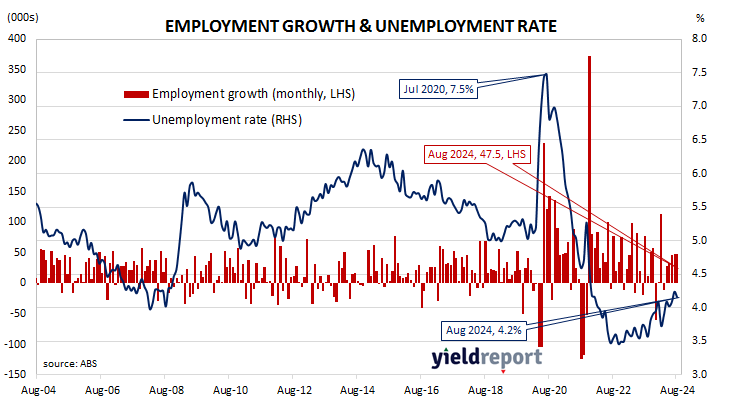Summary: Employment up 47,500 in August, less than expected; Westpac: yet another above-trend gain in employment; ACGB yields rise across slightly flatter curve; rate-cut expectations soften, Feb cut still priced in; Morgan Stanley: labour demand has accelerated over 2024, loosening tight market has been minimal; participation rate steady at 67.1%; jobless rate steady at 4.2%; more part-time jobs, fewer full-time jobs; aggregate work hours up 0.4%; underemployment rate rises to 6.5%.
Australia’s period of falling unemployment came to an end in early 2019 when the jobless rate hit a low of 4.9%. It then averaged around 5.2% through to March 2020, bouncing around in a range from 5.1% to 5.3%. Leading indicators such as ANZ-Indeed’s Job Ads survey and NAB’s capacity utilisation estimate suggested the unemployment rate would rise in the June 2020 quarter and it did so, sharply. The jobless rate peaked in July 2020 but fell below 7% a month later and then trended lower through 2021 and 2022.
The latest Labour force figures have now been released and they indicate the number of people employed in Australia according to ABS definitions increased by 47,500 in August. The result was less than the 58,000 rise which had been generally expected as well as July’s downwardly-revised increase of 48,900.
“This marks yet another above-trend gain in employment,” said Westpac economist Ryan Wells. “Employment growth has slightly outstripped population growth over the past five months, seeing the employment-to-population ratio rise from 64.0% in March to 64.3% in August.”
Commonwealth Government bond yields moved substantially higher across a slightly flatter curve on the day. By the close of business, the 3-year ACGB yield had gained 8bps to 3.44%, the 10-year yield had added 7bps to 3.95% while the 20-year yields finished 5bps higher at 4.31%.
Expectations regarding rate cuts in the next twelve months softened a little, albeit with a February 2025 rate cut still fully priced in. Cash futures contracts implied an average of 4.335% in September, 4.325% in October, 4.285% in November and 4.095% in February 2025. August 2025 contracts implied 3.385%, 95bps less than the current cash rate.
“The labour market remains strong,” said Morgan Stanley economist Chris Read. “Spare capacity has increased from the peak tightness of 2022 but this has entirely been supply-driven, helped by a rise in domestic participation. Labour demand actually looks to have accelerated over 2024 and as a result, loosening progress has been minimal this year.”
The participation rate remained at its series-high of 67.1% as the total available workforce increased by 37,100 to 15.085 million. The number of unemployed persons decreased by 10,400 to 627,000 but the unemployment rate remained steady at 4.2% after rounding.
The aggregate number of hours worked across the economy increased by 0.4% as 50,600 residents gained part-time positions and 3,200 residents lost full-time positions. On a 12-month basis and after revisions, aggregate hours worked increased by 1.7% as 209,900 more people held part-time positions and 164,200 more people held full-time positions than in August 2023.
More attention has been paid to the underemployment rate in recent years, which is the number of people in work but who wish to work more hours than they do currently. August’s underemployment rate increased from 6.3% to 6.5%, 0.6 percentage points above this cycle’s low.
The underutilisation rate, that is the sum of the underemployment rate and the unemployment rate, has a strong correlation with the annual growth rate of the ABS private sector wage index when advanced by two quarters. August’s underutilisation rate of 10.6%* corresponds with an annual growth rate of about 3.9%.
* Underemployment rate: 6.47%, unemployment rate: 4.16%




